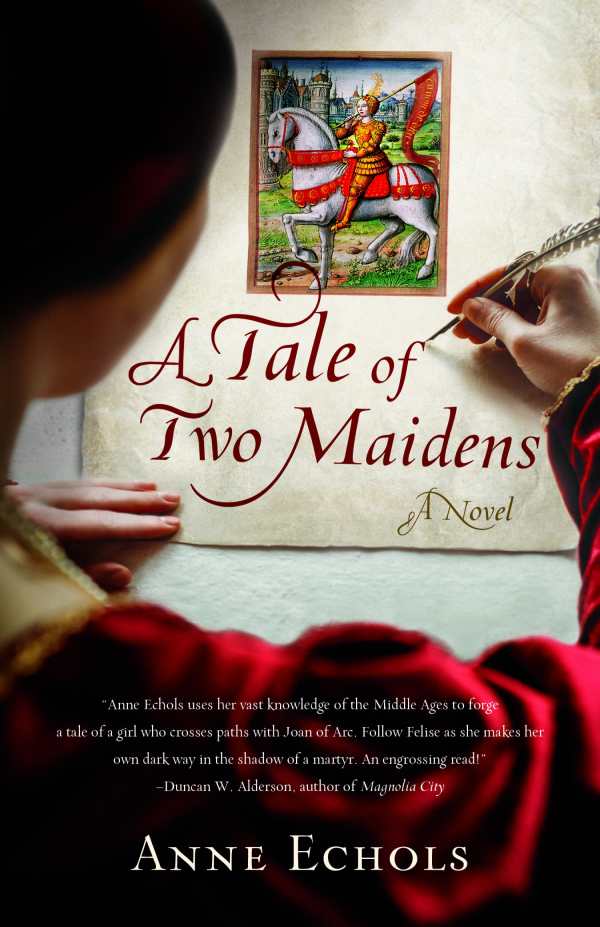A Tale of Two Maidens
A Novel
The historical novel A Tale of Two Maidens covers the last days of Joan of Arc’s campaign with spirited flourishes.
In Anne Echols’s rousing historical novel A Tale of Two Maidens, a girl escapes an arranged marriage by joining Joan of Arc’s crusade.
In 1429, Felise and her sister Ameline live in Troyes, France, amid the prolonged violence of the Hundred Years’ War. Ameline is eighteen and Felise has just marked her fifteenth birthday; though both sisters are of marriageable age, they vow to remain single and independent. Ameline is a skilled seamstress, while Felise is fascinated by writing and stories. Despite her gender, Felise’s literary abilities earn her a position as an apprentice scribe; she aspires to own a bookshop.
The sisters’ plans are thwarted by the debts of their traveling merchant father, Henri. Aggressive moneylenders harass Felise and Ameline for payment, threatening to sell the girls into servitude. Their mother did not survive a recent childbirth, and when Ameline also dies, Felise is forced to live with a ruthless guardian. After the guardian arranges for Felise to marry a widower, Felise leaves Troyes on a stolen horse.
Felise’s escape is hindered by the fact that she is female and accompanied by her mentally challenged Aunt Charlotte. Childlike and with “crescent-shaped” eyes, small, stocky Charlotte is often called an “idiot” and treated with superstitious contempt. To avoid unwanted attention, Felise dresses like a boy and uses the name Philippe, claiming that Charlotte is her sister.
The novel develops the concurrent presence of Jeanne d’Arc, or Jeanne the Maid, as a “mysterious” Catholic peasant girl compelled by visions to liberate France from English occupation. While many French citizens exalt Jeanne as a savior, she is vilified by England’s supporters. Jeanne encounters Felise in her male disguise and allows Felise to take shelter within her army. Charlotte is left in the care of compassionate nuns, and Felise works with Jeanne’s medical “barbers,” who tend to the wounded during battle.
The book’s adroit interweaving of historical details results in a captivating backdrop. Spies abound, like “spider webs.” Lepers carry bells to warn people of their contagious presence, while Hersende the Barberess uses goose fat, garlic, surgical tools, and herbal “concoctions” to save lives. Felise’s father, Henri, is found languishing and emaciated within a hellish debtors’ prison. And Georges, a tanner with whom Felise has a romantic involvement, relates the darker aspects of war and the mortal toll entailed.
The novel’s epilogue, however, is somewhat detached, set two years after the beginning of Felise’s fugitive journey and finding her fortunes much changed. It is rearward-gazing, with Felise recalling Jeanne’s end, praying that she “didn’t suffer long,” and proving reverent but restrained. Yet during her time in Jeanne’s army, Felise witnessed the vulnerability beyond the Maid’s legend; she had at times been Jeanne’s confidante and observed how her initial “joyous” confidence changed to a “gaunt” and troubled demeanor. Felise also watched Jeanne being dressed in battle armor and how her body struggled to bear its formidable weight. Though Jeanne’s valor emboldened Felise to change her own fate, Felise’s reaction to Jeanne’s fiery death seems lacking in true personal anguish.
Through its engaging and defiant heroine, the historical novel A Tale of Two Maidens speaks of Joan of Arc with eloquence, flourishes, and spirit.
Reviewed by
Meg Nola
Disclosure: This article is not an endorsement, but a review. The publisher of this book provided free copies of the book and paid a small fee to have their book reviewed by a professional reviewer. Foreword Reviews and Clarion Reviews make no guarantee that the publisher will receive a positive review. Foreword Magazine, Inc. is disclosing this in accordance with the Federal Trade Commission’s 16 CFR, Part 255.

